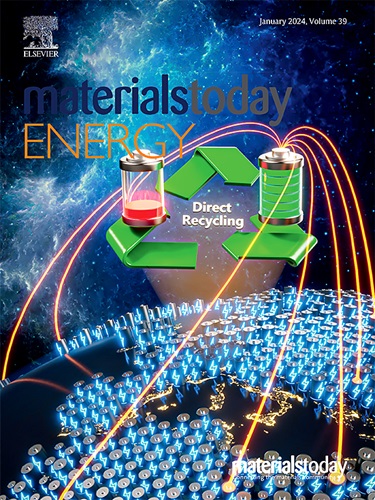A semitransparent organic solar cell with a bifacial factor of 99.1%
IF 8.6
2区 材料科学
Q1 CHEMISTRY, PHYSICAL
引用次数: 0
Abstract
Semitransparent organic solar cells (ST-OSCs) based on silver nanowires (AgNWs) top electrodes have attracted significant interest due to their high transmittance and high electrical conductivity characteristics and showed great potential in the field of building integrated photovoltaics (BIPVs). However, the deposition of AgNWs will partially damage the underlying electron transport layer, leading to poor interfacial performance. Thus, the efficiency of ST-OSCs based on AgNWs still lags behind those based on ultrathin metal electrodes. This work develops a bilayer electron transport layer combining zinc oxide nanoparticles (ZnO) and PDINN to improve the interface between the active layer and the top electrode. The best-performing semitransparent device achieves a remarkable 12.5% power conversion efficiency with an average visible light transmittance of 22.9%. By adjusting the acceptor-to-donor ratio and concentration of the active layer, the ST-OSC can achieve the highest light utilization efficiency of 4.0% with a power conversion efficiency of 9.5%. Furthermore, by further optimizing the top electrode and active layer, a bifacial factor of 99.1% is achieved for the ST-OSCs, which is the highest reported bifacial factor so far. This work provides a promising pathway to develop high-efficiency ST-OSCs for the application of building integrated photovoltaics.

双面系数达 99.1%的半透明有机太阳能电池
基于银纳米线(AgNWs)顶电极的半透明有机太阳能电池(ST-OSCs)因其高透光率和高导电率特性而备受关注,并在光伏建筑一体化(BIPVs)领域展现出巨大潜力。然而,AgNWs 的沉积会部分损坏底层电子传输层,导致界面性能不佳。因此,基于 AgNWs 的 ST-OSCs 的效率仍然落后于基于超薄金属电极的 ST-OSCs。这项研究开发了一种结合氧化锌纳米颗粒(ZnO)和 PDINN 的双层电子传输层,以改善活性层和顶层电极之间的界面。性能最佳的半透明器件实现了 12.5% 的显著功率转换效率和 22.9% 的平均可见光透射率。通过调整有源层的受体-供体比和浓度,ST-OSC 可以达到最高的光利用效率 4.0%,功率转换效率达到 9.5%。此外,通过进一步优化顶部电极和活性层,ST-OSC 的双面因子达到了 99.1%,这是迄今为止报道的最高双面因子。这项工作为开发高效 ST-OSC 应用于光伏建筑一体化提供了一条前景广阔的途径。
本文章由计算机程序翻译,如有差异,请以英文原文为准。
求助全文
约1分钟内获得全文
求助全文
来源期刊

Materials Today Energy
Materials Science-Materials Science (miscellaneous)
CiteScore
15.10
自引率
7.50%
发文量
291
审稿时长
15 days
期刊介绍:
Materials Today Energy is a multi-disciplinary, rapid-publication journal focused on all aspects of materials for energy.
Materials Today Energy provides a forum for the discussion of high quality research that is helping define the inclusive, growing field of energy materials.
Part of the Materials Today family, Materials Today Energy offers authors rigorous peer review, rapid decisions, and high visibility. The editors welcome comprehensive articles, short communications and reviews on both theoretical and experimental work in relation to energy harvesting, conversion, storage and distribution, on topics including but not limited to:
-Solar energy conversion
-Hydrogen generation
-Photocatalysis
-Thermoelectric materials and devices
-Materials for nuclear energy applications
-Materials for Energy Storage
-Environment protection
-Sustainable and green materials
 求助内容:
求助内容: 应助结果提醒方式:
应助结果提醒方式:


